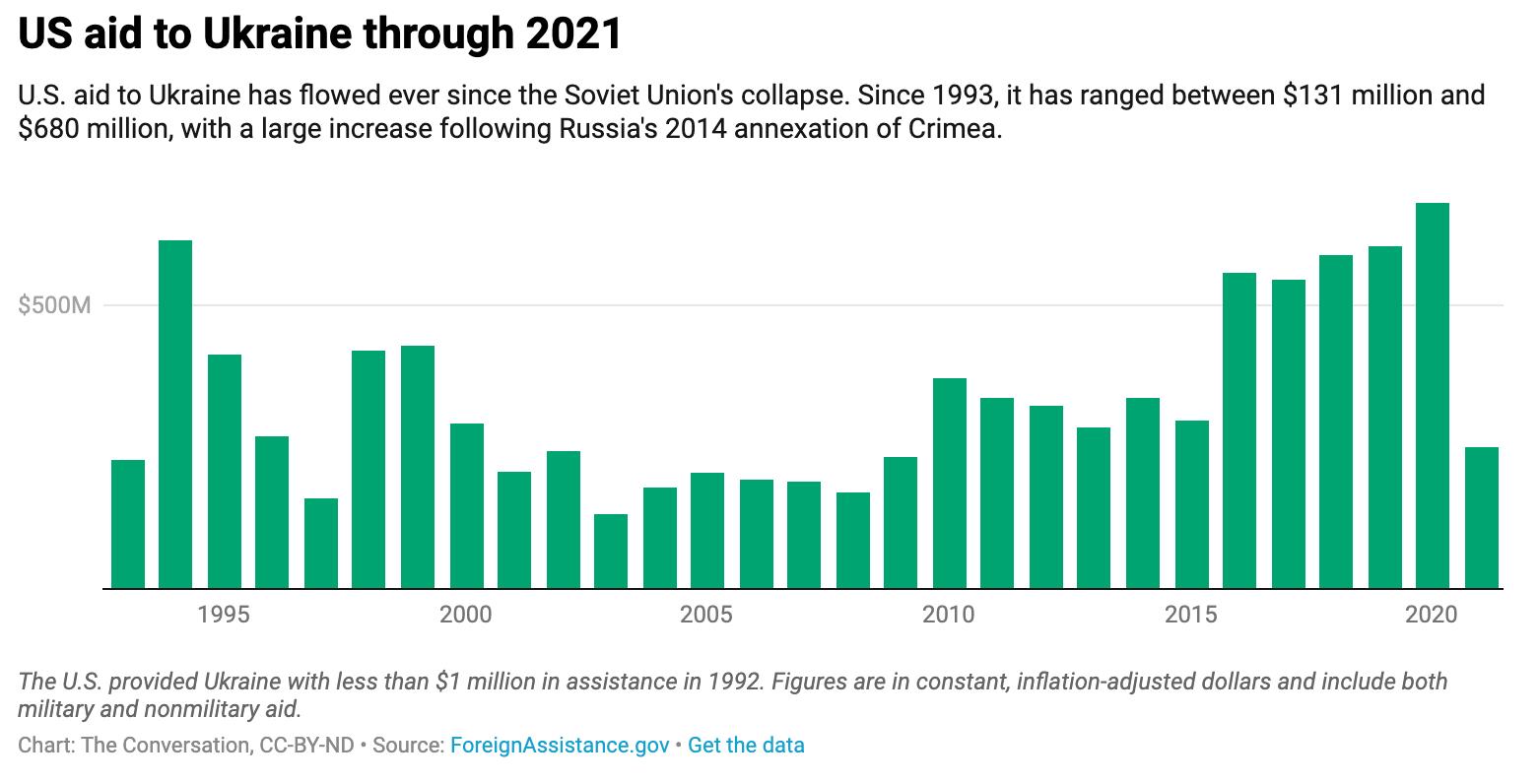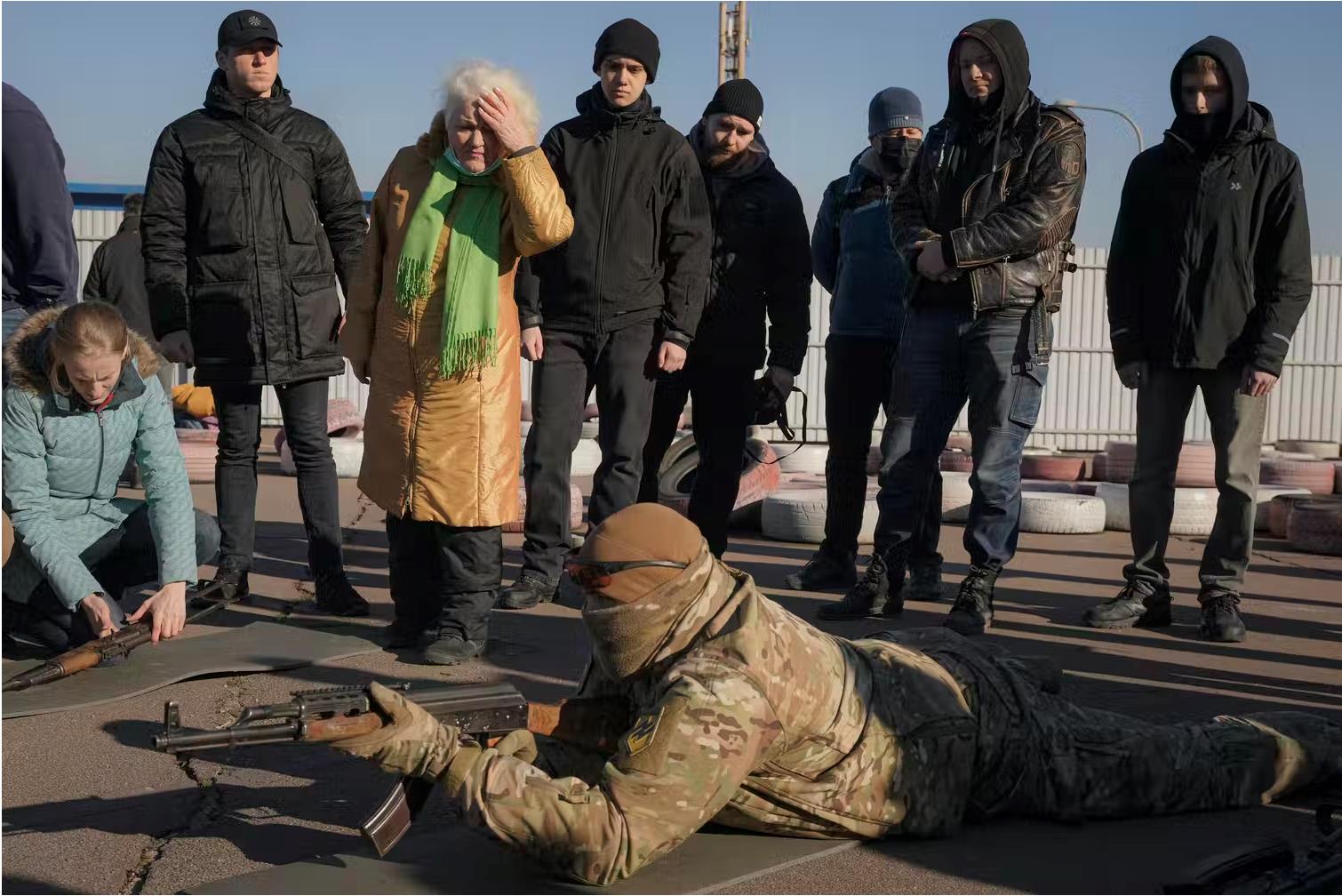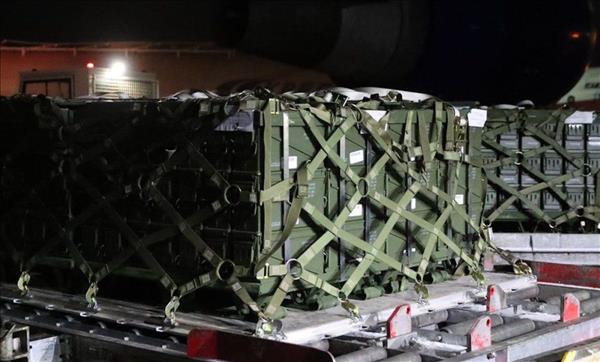Taking the measure of US aid for Ukraine
The US government has condemned Russia's war on Ukraine and vowed to make sure Russia faces consequences for its attack. Political scientist Jessica Trisko Darden , author of“Aiding and Abetting: US Foreign Assistance and State Violence ,” explains how US assistance to Ukraine has changed over the past three decades and its potential implications for security in the region.
1. What has US assistance to Ukraine looked like since the USSR dissolved?Because Ukraine had the world's third-largest nuclear arsenal in 1991, the top U.S. foreign policy objective at first was securing Ukraine's nuclear weapons.
Through the mid-1990s, the US helped Ukraine dismantle missiles, bombers and other nuclear infrastructure. This denuclearization concluded in 1996 with the transfer of its last nuclear warhead to Russia.
The US continued to support Ukraine in what came to be known as the Orange Revolution – mass protests that followed the apparent victory of a pro-Russian presidential candidate widely suspected of fraud. In addition to rhetorical support, the US provided at least $13.8 million to ensure subsequent rounds of the election were free and fair.
US engagement in Ukraine increased dramatically following the Euromaidan Revolution – the wave of protests in late 2013 and 2014 that led to the ouster of then-president Viktor Yanukovych.
Conflict broke out days later, when Russia annexed Crimea, a region in southern Ukraine, and began supporting separatist militias in the eastern part of the country. The US has provided more than $2.7 billion in security assistance since then.
Most of this money has funded weapons, training and intelligence cooperation to help Ukraine fight these militias. More than 14,000 Ukrainians were killed between 2014 and 2021.
Ukraine has also received roughly $418 million annually since 2014 from the State Department and US Agency for International Development (USAID). Some of this is officially“non-lethal assistance,” but it includes items such as body armor, helmets, vehicles, heavy engineering equipment and patrol boats that directly support US and Ukrainian security objectives.
In addition, an average of more than $350 million in US humanitarian aid has flowed to Ukraine annually since 2014. This includes essential relief items such as blankets and food vouchers, hygiene supplies for health centers, training for health care workers, and structural repairs to homes destroyed by conflict.

2. What does Ukraine need now to fight and survive this war?
Many countries are now offering Ukraine military assistance, including $70 million from Australia and $500 million in weapons from the European Union .
Whether and how this aid will be delivered, given ongoing Russian military operations, is unclear. Military analysts emphasize that Ukraine's strategy relies on urban warfare and a protracted war of attrition. While much of the pledged military assistance supports this strategy, arms will be difficult to get into besieged cities such as Kharkiv and Kiev.
Ukraine's survival also requires that Ukrainians abroad continue to support their relatives through remittances while the economy remains disrupted.
3. What is the US currently doing?Ukraine already received most of the weapons from a $200 million military assistance package announced in December 2021. On February 26, 2022, President Joe Biden announced an additional $350 million in US weapons, on top of the US-provided Stinger anti-aircraft weapons and Javelin missile systems being transferred, with US authorization, from Estonia, Latvia and Lithuania to Ukraine.
The US has also reportedly redirected Mi-17 helicopters originally intended for Afghanistan. In addition, USAID announced $25 million more in humanitarian assistance for Ukraine, bringing the total so far for the 2022 fiscal year to $38.6 million .
On the ground, USAID is partnering with United Nations agencies to position critical relief supplies throughout Ukraine, including emergency food, surgery and medical kits, thermal blankets and sanitation supplies.
Even before Russia's invasion, the UN estimated that 3.4 million people required humanitarian assistance due to the ongoing conflict in eastern Ukraine, so I expect humanitarian assistance will continue to increase.
However, providing significantly more funding will be up to Congress. Lawmakers are currently weighing a multibillion-dollar emergency spending bill.
4. Even if this conflict ends quickly, what might Ukraine need in the future?Many countries are pledging military support for Ukraine, but the country will also need help rebuilding after war.
Reconstruction will be complicated by Ukraine's political challenges, including corruption and deeply rooted political regionalism. One option for addressing these challenges is using what are known as“stabilization assistance funds .”
This new US approach to foreign assistance focuses on working simultaneously toward political and security objectives in countries that have recently experienced conflicts.
Unfortunately, the surge in military assistance and weapons for Ukraine is likely to have significant unintended consequences.
The Ukrainian government has called upon anyone willing to take up arms to do so. More than 25,000 automatic rifles, 10 million bullets, and rocket-propelled grenades and launchers have reportedly been distributed in Kiev alone. More guns are on the way, including 1,500 anti-tank weapons from Finland .

Some Ukrainian civilians are learning how to handle weapons from instructors tied to extremist groups. Photo: AP via The Conversation / Vadim Ghirda
Pouring weapons into a country at war may seem reasonable, but this influx of arms can trap a country in conflict.
According to a recent UN report , the proliferation of small arms and light weapons, such as those being distributed in Ukraine, can prolong armed conflict, hinder the implementation of peace agreements and endanger peacekeepers and local civilians.
In short, the weapons being sent to help Ukraine today might make the country more violent in the years to come.
There is also a risk that once the current crisis passes, light weapons could be sold by civilians. Those arms could end up elsewhere in Europe or fall under the control of militias operating in Ukraine, including the far-right Azov battalion .
To reduce that risk, a costly weapons buy-back program may be necessary, although the success of such programs remains hotly debated .
This article is republished from The Conversation under a Creative Commons license. Read the original article .

Legal Disclaimer:
MENAFN provides the
information “as is” without warranty of any kind. We do not accept
any responsibility or liability for the accuracy, content, images,
videos, licenses, completeness, legality, or reliability of the information
contained in this article. If you have any complaints or copyright
issues related to this article, kindly contact the provider above.
Most popular stories
Market Research

- Bitcoin Adoption On Sui Accelerates As Threshold Network And Sui Launch Phase 2 Of Tbtc Integration
- Falcon Finance Announced $FF And Community Sale On Buidlpad
- United States Fin Fish Market Size Forecast With Demand Outlook 20252033
- Bitmex And Tradingview Announce Trading Campaign, Offering 100,000 USDT In Rewards And More
- Virtual Pay Group Secures Visa Principal Acquirer License
- United States Kosher Food Market Long-Term Growth & Forecast Outlook 20252033






















Comments
No comment